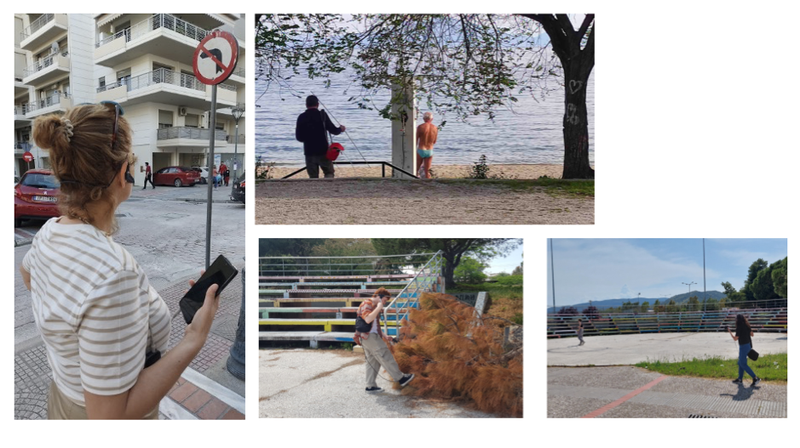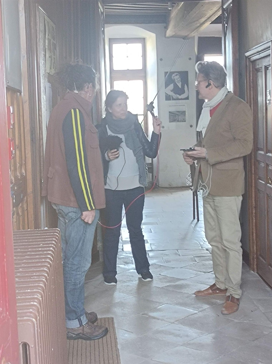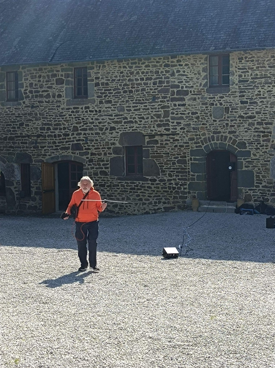In order to tackle the issue of social, environmental and spatial vulnerabilities due to sounds, the architects, designers and artists of the B-AIR Consortium decided not to differentiate the populations to which they are addressed, considering the fact that we all, permanently or temporarily, have found ourselves in vulnerable situations, especially through sounds. Therefore, more general forms of vulnerability through ordinary and everyday listening situations have inspired our work of theoretical reflection on the design of spaces and sounds.
In this frame, an epistemological and ethical approach to the term ‘sympathy’ attempts to investigate the obvious relations that exist between vulnerability and sympathy of spaces and people. Designing spaces by creating ambiances through sympathy enables architects to overpass the empathetic identification and to be more in correspondence with the place.
More specifically, in architecture, the notion of sympathy is perfectly used to express the aesthetic relations of the correspondence between spaces, the ambiances that activate them and the feelings they provide. What interests us in this term is the fact that sympathy allows us to put ourselves in the place of others and to tune in with the world in which we live, in infinite sensitive relationships.
The 95,2FM Sympathy Radio is a methodological tool which uses radio waves to explore attentive listening to sound environments, reveal situations of vulnerability and promote common sympathy practices in the public space. In practice, two sound broadcasters record and transmit live their sounds (composition) on the FM92.5 frequency to three listeners that are wearing bone conduction audio headsets. Listeners by walking are at the same time hearing (naturally and by bone conduction) the surrounding sound environment and the sound compositions of the two sound broadcasters. The FM92.5 Sympathy Radio emerges thus as a method and a tool between a sound installation and a sound performance, like a musical counterpoint between individual and collective soundscapes.

Sympathy radio performances – Volos Anavros park and University of Thessaly Campus
Actions
We may say that the installation is incorporated into the performers. The broadcasters hold an antenna in one hand and the microphone-recorder in the other while carrying a radio transmitter in a small bag. The listeners are wearing bone conduction audio headsets and with their mobile phones they listen to the 92,5FM radio station. Both listeners and broadcasters are moving in different intersected circular transmission zones (with diameters that vary from 50m to 100m, depending on the build environment). So, the broadcaster becomes the antenna and the listener the headsets. The radiophonic electromagnetic waves connect the participants' sound worlds in an unexpected and playful way. Each one has to be very concentrated and sensible in hearing the sounds of their environment. For the broadcasters the goal is to compose their transmission sounds and for the listeners the goal is to perceive them, while they both move around in different, intersected transmission zones. The bone conduction audio headsets are perfect for that use because they simultaneously enable the immersive hearing through bones and the hearing of the airborne ‘real’ sounds through the ears.



Sympathy radio performances – Cerisy conference cultural centre
For the listeners, this is clearly an opportunity to hear the sounds of the place like never before, through this co-presence of direct sounds and sounds transmitted by the radio. It's like seeing a place simultaneously from two different and distant points of view. The listener is confronted with small inconsistencies in the soundscape, which however do not create discomfort (feeling of being lost, assaulted by the sounds) but conduce to a playful state centred on what one listens to, according to one's position in the space. We then grasp all the sounds that we are not used to hearing (sound of footsteps on the ground, sounds of nature which are very often masked - insects, breeze in the leaves, birds). Listening switches constantly between hearing and listening, as to resume the words of Pierre Schaefer (écouter, ouïr, entendre, comprendre). We don't always understand what we hear, but the experience is often marked by surprise and joy.

Sympathy radio performances – Cerisy conference cultural centre – (source : Flampouris, Paxinou, Remy in https://sympathyradio.wixsite.com/sympathy-radio)

Sympathy radio performances – Cerisy conference cultural centre
For the broadcaster(s), it is a way of composing the sound world while s/he traverses it with the antenna and the microphone. Like any sound recorder, the broadcaster has the audio feedback on the sounds he transmits and he is responsible for his/her sound emissions. When there are not many sound events, the broadcasters feel disconnected, insecure and vulnerable. The absence of sound events to transmite activates the need to create and produce sounds. Sounding the world is therefore a way to deal with the vulnerabilities of listening. The search for sound sources engages her/his body in motion with specific movements, sometimes small and delicate and sometimes fast and sharp, in order to bring the microphone closer to what she/he wants to offer for listening. The microphone body leans towards a source, rises in the air to capture the sound of a bird better; the broadcaster uses her/his feet to play with the materiality of the ground, grabs a stick or a metal rod to strike a wall or a metal pillar, etc. The broadcaster enters into an endless dance while he composes his sound production of events unfolding in front of him, to tell his story from a distance: he approaches a group, participates in their conversation, then moves away from it to hear better and make other sounds.
Using “92,5FM Sympathy radio” is therefore a listening game that enables us to hear the sonic world. It is a playful game where we can listen to our environment and be heard by it - a game of trying to enter into sympathy.

Sympathy radio performances – Cerisy conference cultural centre
92,5FM Sympathy radio was used to create a sound piece “M’Akous? - Do you hear me?” that was played at XVIII Venice International Architecture Biennale in August 2023, within the framework of the Radio Utopia, le bal des sonorités (dir. Carlotta Darò, Nicolas Tixier)
Duration 07:13
Created by Paxinou Evangelia, Flampouris Petros and Remy Nicolas
See also: Cerisy Days